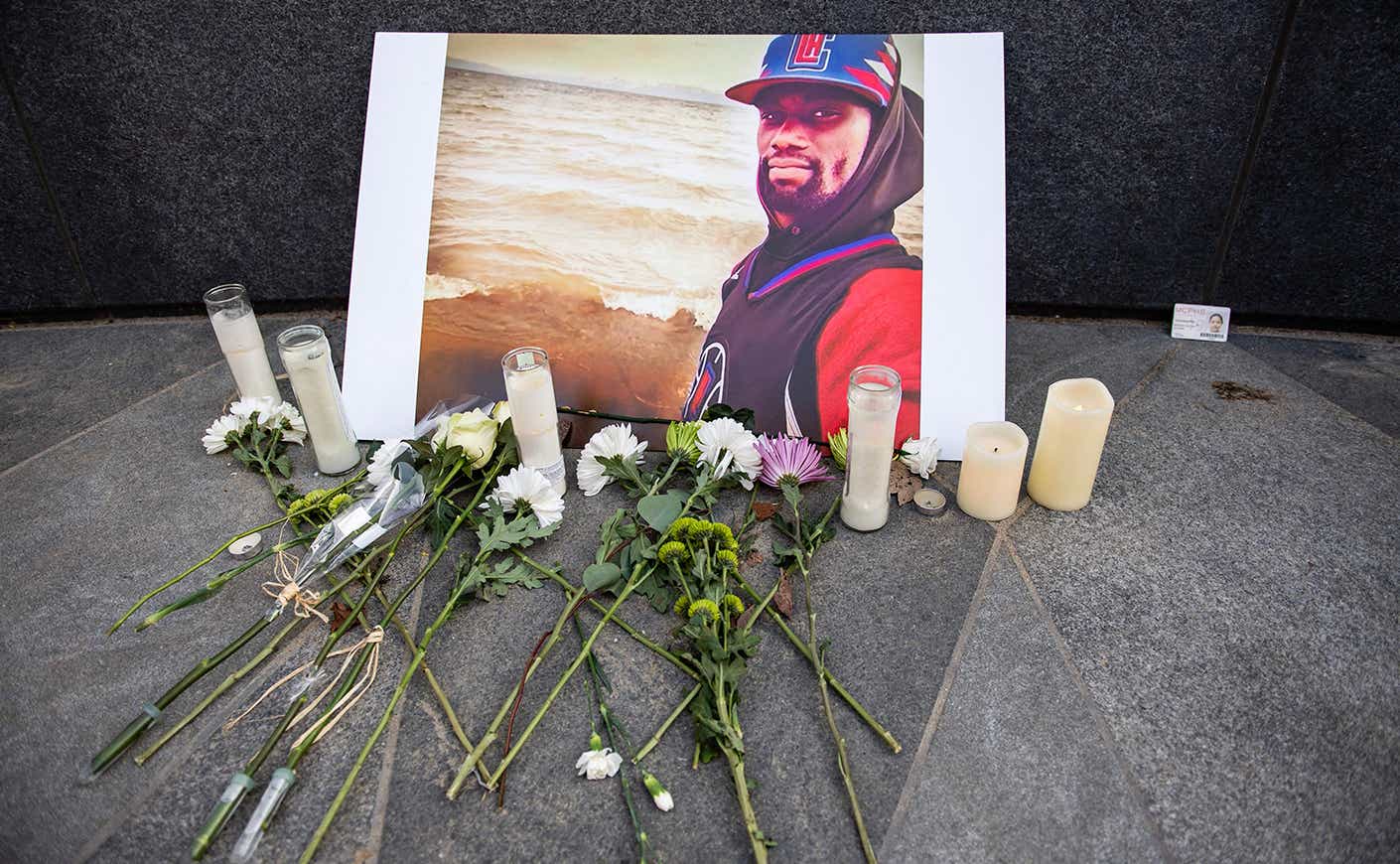Protests have popped up across the country following the public release of video footage of the fatal beating of 29-year-old Tyre Nichols at the hands of five Memphis police officers. In the days leading up to the video’s release, Nichols’ family urged people to protest peacefully. The video, which includes footage from police body cameras and a surveillance camera, has already had an impact in Memphis as it reinvigorates conversations about ending police brutality nationwide.
What happened to Tyre Nichols?
On Jan. 7, Tyre Nichols was pulled over by police when he was mere minutes from his home for what they claimed was reckless driving — a claim Memphis Police Chief Cerelyn Davis said authorities have not been able to substantiate. What ensued was violence that Davis called “unconscionable”: At one point, Nichols was sprayed with pepper spray while he was lying on the ground. Later, officers hit him while his hands were restrained. An ambulance did not arrive at the scene until around 25 minutes after the beating stopped, NY Times reports. Nichols died on Jan. 10 of “extensive bleeding caused by a severe beating,” according to an autopsy commissioned by his family.
What Tyre Nichols’ family says about the video
Nichols’ family watched the footage ahead of its public release, after meeting with Chief Davis. Nichols’ mother, RowVaughn Wells, told the Washington Post that she watched for less than a minute before she had to leave the room. She told a local Memphis news station, “I’ve never seen the video, but from what I’ve heard, it’s very horrific.” She added, “If you have children, please don’t let them see it.”
Despite the extremely upsetting nature of the video, Ben Crump, an attorney for Nichols’ family, told MSNBC that the family wanted the footage to be released to the public. “They think it’s important that America, that the world, see how [officers] brutalized Tyre, how they killed Tyre so unnecessarily,” he said.
The footage is extremely disturbing, and some argue, should not be viewed
Memphis Police Chief Davis said the footage depicts “acts that defy humanity.” Nichols’ fatal beating is being compared to the 1991 assault of Rodney King by members of the LAPD — Crump called Nichols’ death “Rodney King, Part 2” in a tweet. Lora Dene King, King’s daughter, says that watching videos of police brutality is “disturbing” and the fact that these violent incidents continue to happen is a huge problem.
”This is extremely sickening,” she said in a statement. “We should not have to witness such things in this world over and over with a different name behind the hashtags.”
While there have been instances where graphic depictions of racism and police brutality have impacted public opinion — pictures of Emmett Till’s body helped reinvigorate the Civil Rights movement in the 1950s, and George Floyd’s death, which was captured on video, inspired global protests for racial justice — many activists argue that we should not view this type of footage. Furthermore, we shouldn’t need to in order to feel moved to action. Bernice A. King tweeted, “You don’t have to watch the video of [Tyre Nichols] being beaten by police.” She added, “It should not require another video of a Black human being dehumanized for anyone to understand that police brutality is an urgent, devastating issue.”
And while social media’s ability to rapidly share information can be a positive force, disseminating graphic videos such as this can cause harm to social media users, who can’t always choose what they encounter when they are scrolling on a feed.
Alissa V. Richardson, journalist and author of Bearing Witness While Black: African Americans, Smartphones and the New Protest #Journalism, tells Vox that sharing videos of police brutality can be traumatic, particularly for Black people. “Many black people see themselves lying on the ground, they see a relative, someone who looks like them — it could be them,” she says.
Gerald Griggs, the president of the Georgia NAACP, tweeted that with the release of the video, Black folks “will once again be traumatized by witnessing the brutal murder of another black man at the hands of those who are allegedly here to ‘serve and protect’ us.”
A police task force was deactivated following Nichols’ death
A day after the release of the footage, the Memphis Police Department announced the SCORPION unit was “permanently” disbanded. The unit, which stands for Street Crimes Operation to Restore Peace in Our Neighborhoods, started in November 2021 and consisted of 40 officers. The officers patrolled “high crime hotspots,” which were chosen based on the number of 911 calls. They were meant to focus on auto thefts and gang-related and drug-related crimes, according to the MPD Assistant Chief at the time. The five police officers involved in Nichols’ beating, who have been fired and charged with second-degree murder and since released on bond, were all members of the unit.
His death is also renewing calls for police reform legislation
Some Memphis city council members don’t believe disbanding the SCORPION unit goes far enough. City council chair Martavius Jones told CNN the move is akin to “putting lipstick on a pig.” Two Democratic lawmakers said they intend to file legislation aimed at police reform before Tuesday. The proposed legislation would address hiring, training, discipline practices, mental health care, and other issues.
Protestors in Memphis, who gathered over the weekend and blocked the Interstate 55 bridge, called for information on all the officers and personnel involved in Nichols’ death to be released. They are also demanding an end to pretextual traffic stops, where an officer can pull someone over for a traffic violation and then use it to investigate a more serious crime, and for other Memphis PD units and task forces to be dissolved.
Crump called on Congress to pass the George Floyd Justice in Policing Act, which passed the House in 2021 but not the Senate. The bill aimed to restrict qualified immunity, prevent racial profiling, and limit the use of excessive force. Crump also said at a press conference that the speed with which the officers were fired and charged should be “the blueprint going forward for any time, any officers, whether they be Black or white” for accusations of excessive force.
Sen. Dick Durbin, chairman of the Senate Judiciary Committee, said that Congress needs to refocus on police reform legislation. “We need a national conversation about policing in a responsible, constitutional, and humane way,” he said. Steven Horsford, the Congressional Black Caucus Chair, said in a statement on Sunday, “We are calling on our colleagues in the House and Senate to jumpstart negotiations now and work with us to address the public health epidemic of police violence that disproportionately affects many of our communities.” He also expressed the intention to set up a meeting between the CBC and President Biden, “to push for negotiations on much needed national reforms to our justice system — specifically, the actions and conduct of our law enforcement.”
Honoring Tyre Nichols’ life
Tyre Nichols was an amateur photographer who enjoyed capturing sunsets. He loved skateboarding and hoped to one day start a graphic design company. He worked the overnight shift at FedEx, and a coworker said he took extra care to make sure customers received the correct items. Nichols was the youngest of four children and had a four-year-old son.
“Tyre Nichols was loved by his community and was known to be gentle, kind, and joyful,” a GoFundMe page created by his mother, RowVaughn Wells, reads.
“I just think about the fact that I’ll never see my son again,” Wells, told NBC News. “I’ll never see that smile again. He’ll never see his son grow up.”
Wells’s GoFundMe will help cover her and her husband’s mental health care and time off from work. She also wrote that she wants to build a memorial skate park for Nichols, “in honor of his love for skateboarding and sunsets.”









